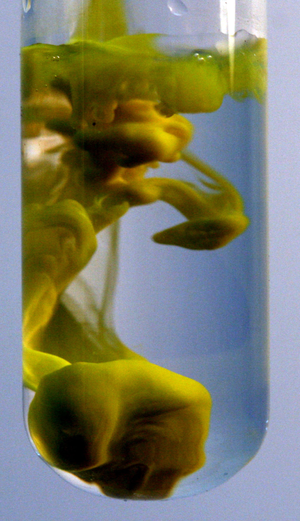Difference between revisions of "Precipitate"
| Line 3: | Line 3: | ||
===Meaning=== | ===Meaning=== | ||
A [[precipitate]] is a [[solid]] [[insoluble]] [[compound]] formed by the [[Chemical Reaction|chemical reaction]] between two other [[chemical]]s in [[solution]]. | A [[precipitate]] is a [[solid]] [[insoluble]] [[compound]] formed by the [[Chemical Reaction|chemical reaction]] between two other [[chemical]]s in [[solution]]. | ||
| + | |||
| + | ===About Precipitates=== | ||
| + | : The [[reactant]]s in a '''precipitation''' [[Chemical Reaction|reaction]] are [[aqueous]] or [[gas]]eous but at least one of the [[product]]s is an [[insoluble]] [[solid]]. | ||
| + | : Some common [[precipitate]] [[Chemical Reaction|reactions]] you may know are: | ||
| + | : Lead Nitrate + Potassium Iodide → Potassium Nitrate + Lead Iodide | ||
| + | <math>Pb(NO_3)_2(aq) + 2KI(aq) → 2KNO_3(aq) + PbI_2(s)</math> | ||
| + | |||
| + | : [[Calcium Oxide]] + [[Carbon Dioxide]] → [[Calcium Carbonate]] | ||
| + | <math>CaO(aq) + CO_2(g) → CaCO_3(s)</math> | ||
Revision as of 09:44, 8 June 2019
Key Stage 4
Meaning
A precipitate is a solid insoluble compound formed by the chemical reaction between two other chemicals in solution.
About Precipitates
- The reactants in a precipitation reaction are aqueous or gaseous but at least one of the products is an insoluble solid.
- Some common precipitate reactions you may know are:
- Lead Nitrate + Potassium Iodide → Potassium Nitrate + Lead Iodide
\(Pb(NO_3)_2(aq) + 2KI(aq) → 2KNO_3(aq) + PbI_2(s)\)
\(CaO(aq) + CO_2(g) → CaCO_3(s)\)
